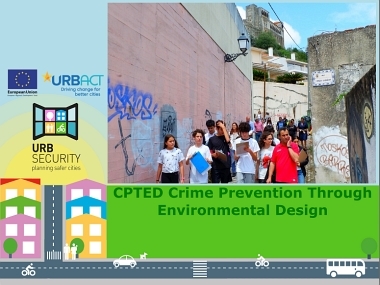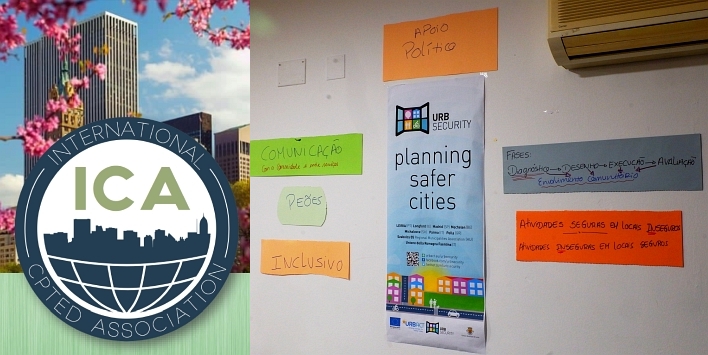CPTED and Perceptions of Insecurity in Public Spaces
Edited on
31 August 2022The CPTED - Crime Prevention Through Environmental Design is a multidisciplinary approach that uses various tools to assess context and use intervention methods to control human/criminal behavior and reduce fear of crime and perception of safety in public space.

CPTED is a multidisciplinary approach to deterring unwanted or criminal behavior and integrates principles from the following subject areas:
- Architecture
- Landscape Architecture
- Security Forces
- Engineering
- Sociology
- Urban planning
Its concepts have been developed and refined over the years by (among others), Jane Jacobs (1916 - 2006), Elisabeth Wood (1899 - 1993), Charles Ray Jeffery (1921 - 2007), Oscar Newman (1935 - 2004), and Timothy D. Crowe (1949 - 2009).
We observe the following models of Criminal Prevention
- Community Prevention - or local prevention, uses programs aimed at "changing conditions in neighborhoods that influence delinquency, victimization and the insecurity that results from crime, based on initiatives with the knowledge and commitment of community members".
- Situational Prevention - programs designed to prevent crime from occurring by reducing opportunities and increasing risks. Aims to minimize benefits and provide assistance and information to victims.
- Prevention with Reintegration Programs - prevention of recidivism through support to offenders' social reintegration and other prevention mechanisms (Fernandes, 2010)
Crime Prevention is the anticipation, recognition, and detection of a crime risk and action to reduce the risk of crime occurring. Urban design can encourage or discourage unwanted behavior and/or the commission of crime.

Like people so do spaces communicate :
- Information to criminals about potential targets;
- Individual clues-"good" or "safe" targets, or "bad" or "unsafe" targets;
- Offenders learn to recognize favorable locations/situations for their activities...
The goal of CPTED is to reduce opportunities for crime. Opportunities that result from the design characteristics of neighborhoods and space. One of the goals is to try to make targets harder to break into (Target hardening).
And all human space should have the following characteristics :
- Have a designated purpose;
- Contain social, cultural, legal or physical definitions. These guide desirable and acceptable behavior;
- Be designed to support and control desired behavior.

The European Council adopted conclusions on CPTED (8094/11). CPTED is a multi-disciplinary approach to deterring criminal behaviour: it is based on the theory that the physical environment influences human behaviour. CPTED strategies rely upon the ability to influence offender decisions that precede criminal acts.
Therefore member states are encouraged to apply CPTED in all relevant urban planning applications and to promote the adoption of the philosophy and principles of CPTED by police forces and local authorities, in order to improve the quality of life for the community.”

CPTED - Principles :
1. Natural access control
2. Natural surveillance
3. Territorial reinforcement
4. Maintenance
5. Community participation
CPTED - Concentrates :
- Physical Context
- Behavior of individuals
- Productive use of space
- Crime reduction / prevention
CPTED - Strategies :
- Reconstruct space use to create natural barriers in conflicting activities.
- Improve or manage spaces to allow effective use at times of greatest concentration/use.
- Clear demarcation for control of space.
- Clearly marked transition zones.
- Relocate concentration zones in places of natural surveillance and controlled access or in locations away from those where potential offenders may concentrate.
- Placement of safe activities in unsafe locations to promote natural surveillance of these activities to increase the safety of those attending and increase the risk of offenders.
- Placement of unsafe activities in safe locations to overcome the vulnerability of these activities with natural surveillance and access control of the safe area.
- Requalification or renovation of the space to increase natural surveillance.
- Compensating for distance and isolation by improving communication and urban design.
CPTED - Benefits :
- Reduced crime.
- Reduced likelihood of crime.
- Increased sense of safety and comfort.
- Enhancement of the physical environment.
- Increased quality of life.
- Revitalization and preservation of neighborhoods / territories.
- Increased business activity / trade.
- Permanence of the middle class in the cities.
- More efficient use of city resources for crime prevention.
- Different city services and departments working for a common good in an integrated and strategic way.
- Improved relationship between city services and the population.
- Positive environment for investment - because of the tranquility that is generated.

CPTED - potential problems in implementation :
- Problems experienced by municipalities:
- Lack of coordination between different departments
- Lack of resources (human and financial)
- Need for training
- Resistance by the community responsible for urban design
- Resident Associations
- Public in general
- Private investors opposed to costs
- Private investors opposed to slowness
- Aesthetics vs. safety
- Increased concerns in historical context
- Stigmatization of sites
- Consensus decisions about the territory

CPTED - ICA METHODOLOGY ( International CPTED Association )
1. Diagnosis - very important
2. Design - with community involvement, negotiations
3. Implementation / execution - with community participation, work of trust
4. Evaluation - periodic, questionnaire survey, focus groups, observation.
Devolution of results to the population
CPTED is not the answer to all the problems of a territory, but it provides means, tools, and strategies to improve the quality of life of the populations that benefit from its implementation. Timothy D. Crowe

CPTED training content by Ana Veronica Neves, ICA Director.
Adapted and translated by Luis Pinela
links
Standard CEN http://www.costtu1203.eu/downloads/other-documents/
ICA – International CPTED Association https://www.cpted.net/ https://www.cpted.net/ICA-newsletters
https://cpted.net/resources/Documents/ICA%20Resources/Newsletters/The%20ICA%20Newsletter-June%202021.pdf
Situational Crime Prevention http://www.inthebag.org.uk/wp-content/uploads/2008/02/techniques-of-theft-prevention.pdf
National Crime Prevention Council, CPTED Guidebook https://www.ncpc.org.sg/images/media/CPTED.pdf
https://www.youtube.com/channel/UCO-G-6w6W3wXZSZ7X6zH16Q
Submitted by Patricia Moital on
